Human Respiratory and Cardiac Systems
VerifiedAdded on 2020/06/06
|11
|2751
|137
AI Summary
The assignment delves into the human respiratory and cardiac systems. It describes the structures involved in both systems and explains their functions. The assignment also touches upon the measurement of vital signs like heart rate and respiratory rate, and provides information on various medical conditions affecting these systems.
Contribute Materials
Your contribution can guide someone’s learning journey. Share your
documents today.

Task 27 - Human Respiratory
and Cardiac Systems
and Cardiac Systems
Secure Best Marks with AI Grader
Need help grading? Try our AI Grader for instant feedback on your assignments.
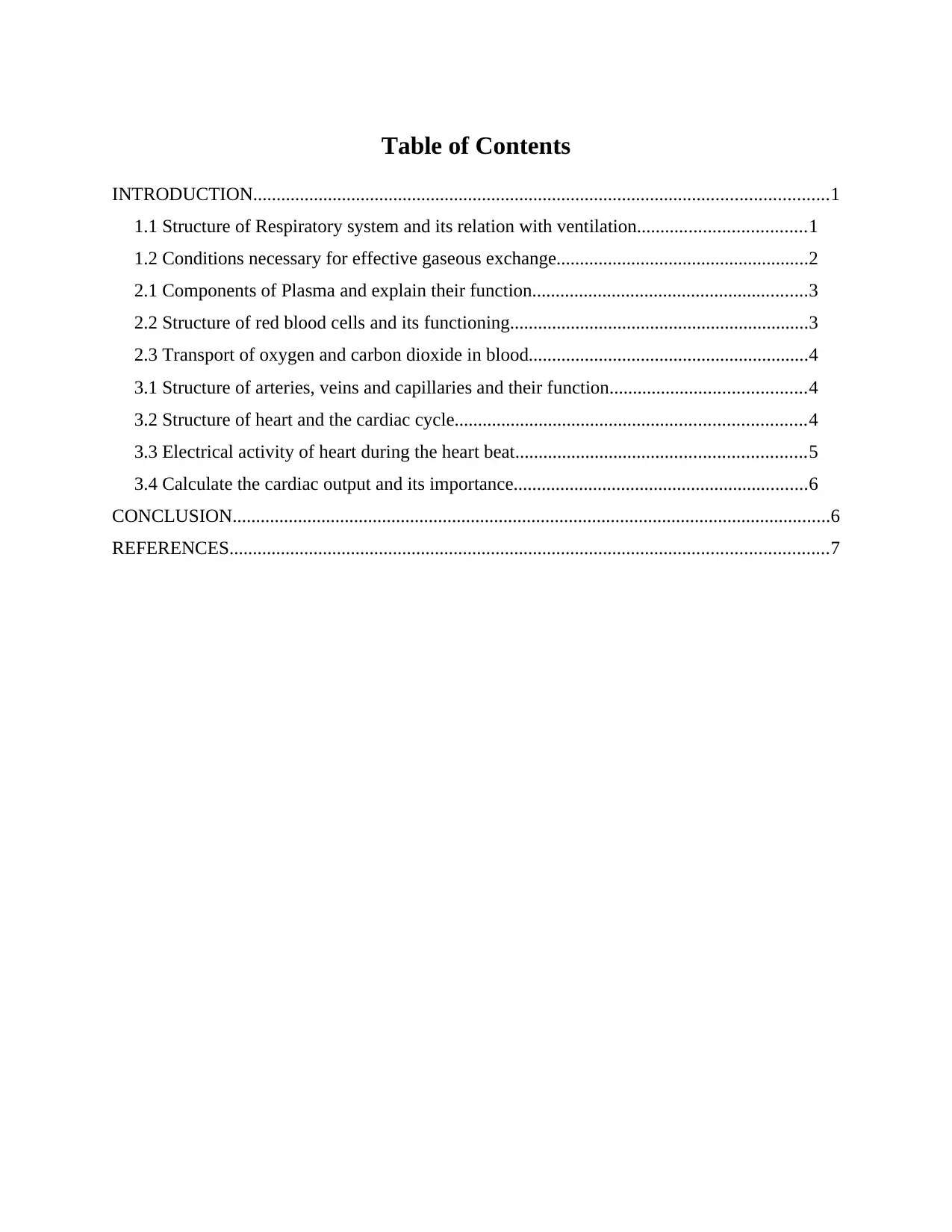
Table of Contents
INTRODUCTION...........................................................................................................................1
1.1 Structure of Respiratory system and its relation with ventilation....................................1
1.2 Conditions necessary for effective gaseous exchange......................................................2
2.1 Components of Plasma and explain their function...........................................................3
2.2 Structure of red blood cells and its functioning................................................................3
2.3 Transport of oxygen and carbon dioxide in blood............................................................4
3.1 Structure of arteries, veins and capillaries and their function..........................................4
3.2 Structure of heart and the cardiac cycle...........................................................................4
3.3 Electrical activity of heart during the heart beat..............................................................5
3.4 Calculate the cardiac output and its importance...............................................................6
CONCLUSION................................................................................................................................6
REFERENCES................................................................................................................................7
INTRODUCTION...........................................................................................................................1
1.1 Structure of Respiratory system and its relation with ventilation....................................1
1.2 Conditions necessary for effective gaseous exchange......................................................2
2.1 Components of Plasma and explain their function...........................................................3
2.2 Structure of red blood cells and its functioning................................................................3
2.3 Transport of oxygen and carbon dioxide in blood............................................................4
3.1 Structure of arteries, veins and capillaries and their function..........................................4
3.2 Structure of heart and the cardiac cycle...........................................................................4
3.3 Electrical activity of heart during the heart beat..............................................................5
3.4 Calculate the cardiac output and its importance...............................................................6
CONCLUSION................................................................................................................................6
REFERENCES................................................................................................................................7

Illustration Index
Illustration 1: Human Respiratory system.......................................................................................1
Illustration 2: Human heart..............................................................................................................5
Illustration 1: Human Respiratory system.......................................................................................1
Illustration 2: Human heart..............................................................................................................5
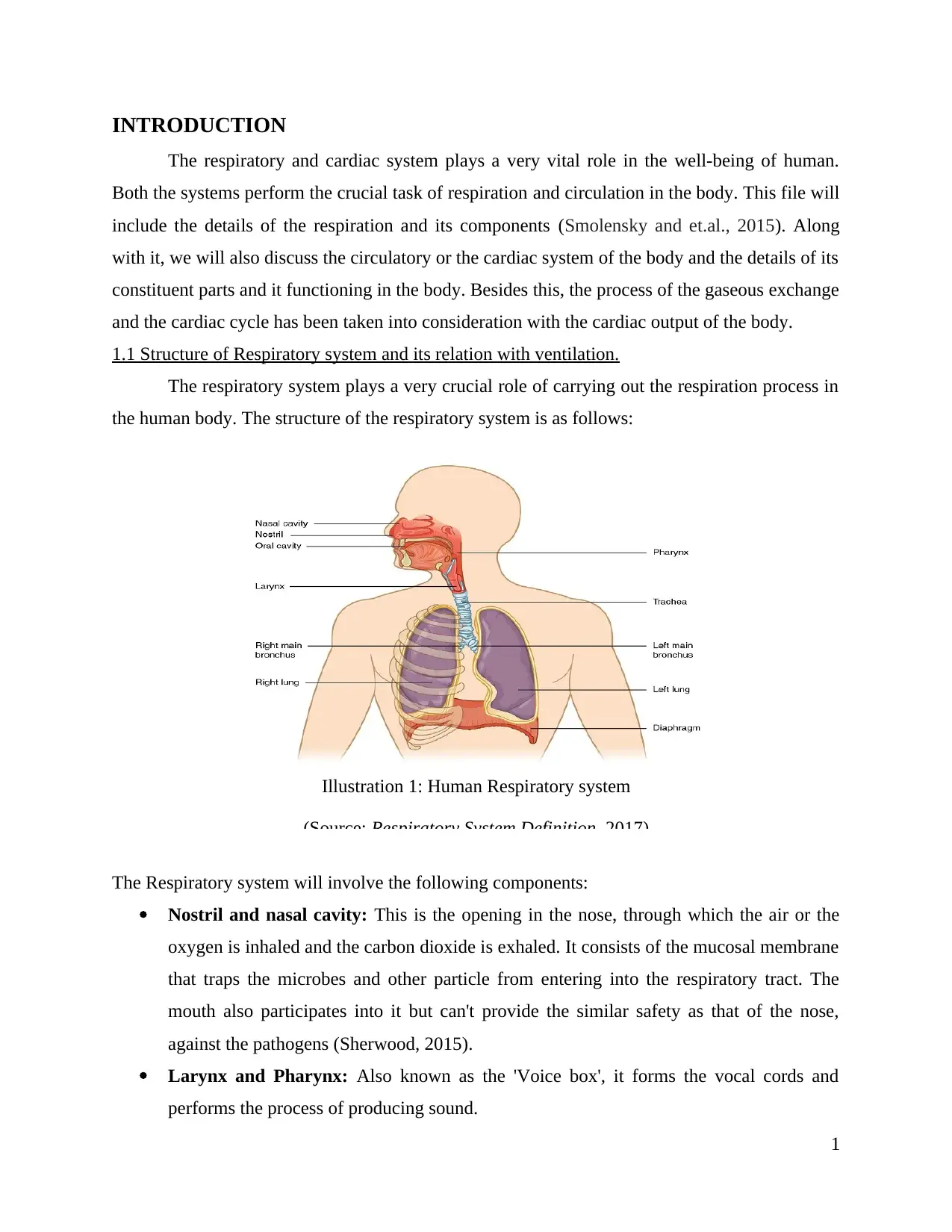
INTRODUCTION
The respiratory and cardiac system plays a very vital role in the well-being of human.
Both the systems perform the crucial task of respiration and circulation in the body. This file will
include the details of the respiration and its components (Smolensky and et.al., 2015). Along
with it, we will also discuss the circulatory or the cardiac system of the body and the details of its
constituent parts and it functioning in the body. Besides this, the process of the gaseous exchange
and the cardiac cycle has been taken into consideration with the cardiac output of the body.
1.1 Structure of Respiratory system and its relation with ventilation.
The respiratory system plays a very crucial role of carrying out the respiration process in
the human body. The structure of the respiratory system is as follows:
The Respiratory system will involve the following components:
Nostril and nasal cavity: This is the opening in the nose, through which the air or the
oxygen is inhaled and the carbon dioxide is exhaled. It consists of the mucosal membrane
that traps the microbes and other particle from entering into the respiratory tract. The
mouth also participates into it but can't provide the similar safety as that of the nose,
against the pathogens (Sherwood, 2015).
Larynx and Pharynx: Also known as the 'Voice box', it forms the vocal cords and
performs the process of producing sound.
1
Illustration 1: Human Respiratory system
(Source: Respiratory System Definition, 2017)
The respiratory and cardiac system plays a very vital role in the well-being of human.
Both the systems perform the crucial task of respiration and circulation in the body. This file will
include the details of the respiration and its components (Smolensky and et.al., 2015). Along
with it, we will also discuss the circulatory or the cardiac system of the body and the details of its
constituent parts and it functioning in the body. Besides this, the process of the gaseous exchange
and the cardiac cycle has been taken into consideration with the cardiac output of the body.
1.1 Structure of Respiratory system and its relation with ventilation.
The respiratory system plays a very crucial role of carrying out the respiration process in
the human body. The structure of the respiratory system is as follows:
The Respiratory system will involve the following components:
Nostril and nasal cavity: This is the opening in the nose, through which the air or the
oxygen is inhaled and the carbon dioxide is exhaled. It consists of the mucosal membrane
that traps the microbes and other particle from entering into the respiratory tract. The
mouth also participates into it but can't provide the similar safety as that of the nose,
against the pathogens (Sherwood, 2015).
Larynx and Pharynx: Also known as the 'Voice box', it forms the vocal cords and
performs the process of producing sound.
1
Illustration 1: Human Respiratory system
(Source: Respiratory System Definition, 2017)
Secure Best Marks with AI Grader
Need help grading? Try our AI Grader for instant feedback on your assignments.

Trachea and bronchi: It forms the windpipe, which goes along with the oesophagus or
the food pipe and connects the upper level of the respiratory system with both the lungs.
Lungs: It is the most important constituent part of the respiratory system as it is where
the respiration process takes place. The alveoli in the lungs will consume the oxygen
from the inhaled air and will give out the carbon dioxide from the blood, back in the form
of exhaled air.
The process of the respiration is quite different from that of the ventilation. While the
process of ventilation is the intake and giving out of the air on the basis of the volume of the
lungs, respiration is the exchange of the oxygen and carbon dioxide that take place between the
ventilation process (Nedoma and et.al., 2017).
1.2 Conditions necessary for effective gaseous exchange.
Various conditions are to be taken into consideration for the better execution of
respiration process of gaseous exchange. The gaseous exchange takes place in the body with the
help of respiratory and cardiac system of human body. Different factors that have been taken into
notice or which affect better gaseous exchange in the body such as:
Temperature: The temperature plays a very significant role in carrying out the gaseous
exchange in the body. As the temperature of the body or the environment increases, the
need of oxygen in the body increases and thus, the gaseous exchange between alveoli and
blood increases.
Rapid ventilation: The rise in the body's ventilation rate due to various factors such as
running, working out, swimming etc. This rise in the ventilation process helps in better
equilibrium of oxygen and carbon dioxide in the body.
Cell membranes: The cell membranes of the blood vessels and alveoli also play a very
significant role in the gaseous exchange. The thinner the cell membranes, the higher the
chances of gaseous diffusion between blood and lungs (Zimmer and et.al., 2016).
Surface ratio: The surface ration or the density of the alveoli also plays a very deep role
in the gaseous exchange. The high concentration of the alveoli in the lungs will lead to
increase rate of gaseous exchange in the body.
2.1 Components of Plasma and explain their function
Plasma also known as the blood plasma is a yellowish white mostly colourless liquid that
makes the major part of human blood. This is made up of water and a protein known as albumin.
2
the food pipe and connects the upper level of the respiratory system with both the lungs.
Lungs: It is the most important constituent part of the respiratory system as it is where
the respiration process takes place. The alveoli in the lungs will consume the oxygen
from the inhaled air and will give out the carbon dioxide from the blood, back in the form
of exhaled air.
The process of the respiration is quite different from that of the ventilation. While the
process of ventilation is the intake and giving out of the air on the basis of the volume of the
lungs, respiration is the exchange of the oxygen and carbon dioxide that take place between the
ventilation process (Nedoma and et.al., 2017).
1.2 Conditions necessary for effective gaseous exchange.
Various conditions are to be taken into consideration for the better execution of
respiration process of gaseous exchange. The gaseous exchange takes place in the body with the
help of respiratory and cardiac system of human body. Different factors that have been taken into
notice or which affect better gaseous exchange in the body such as:
Temperature: The temperature plays a very significant role in carrying out the gaseous
exchange in the body. As the temperature of the body or the environment increases, the
need of oxygen in the body increases and thus, the gaseous exchange between alveoli and
blood increases.
Rapid ventilation: The rise in the body's ventilation rate due to various factors such as
running, working out, swimming etc. This rise in the ventilation process helps in better
equilibrium of oxygen and carbon dioxide in the body.
Cell membranes: The cell membranes of the blood vessels and alveoli also play a very
significant role in the gaseous exchange. The thinner the cell membranes, the higher the
chances of gaseous diffusion between blood and lungs (Zimmer and et.al., 2016).
Surface ratio: The surface ration or the density of the alveoli also plays a very deep role
in the gaseous exchange. The high concentration of the alveoli in the lungs will lead to
increase rate of gaseous exchange in the body.
2.1 Components of Plasma and explain their function
Plasma also known as the blood plasma is a yellowish white mostly colourless liquid that
makes the major part of human blood. This is made up of water and a protein known as albumin.
2
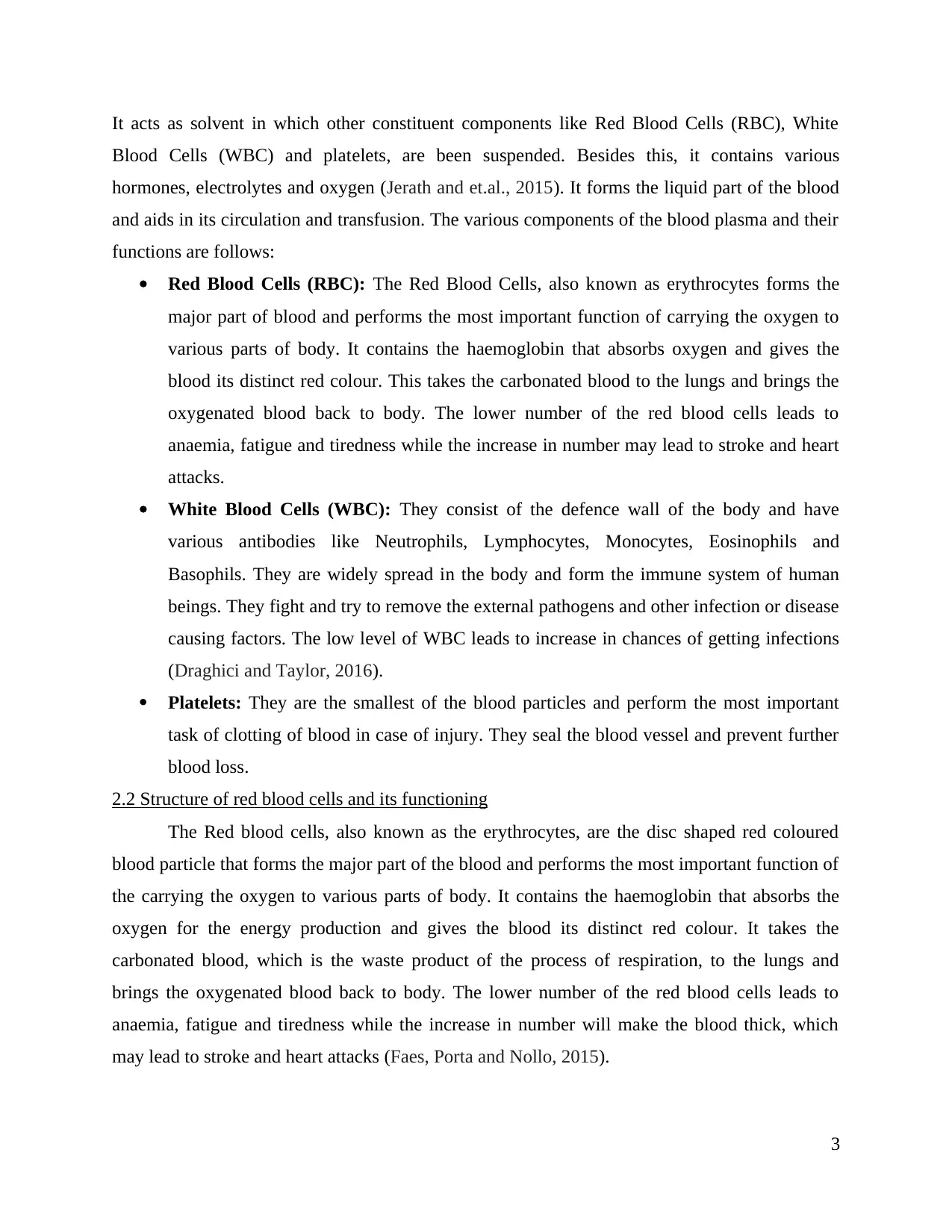
It acts as solvent in which other constituent components like Red Blood Cells (RBC), White
Blood Cells (WBC) and platelets, are been suspended. Besides this, it contains various
hormones, electrolytes and oxygen (Jerath and et.al., 2015). It forms the liquid part of the blood
and aids in its circulation and transfusion. The various components of the blood plasma and their
functions are follows:
Red Blood Cells (RBC): The Red Blood Cells, also known as erythrocytes forms the
major part of blood and performs the most important function of carrying the oxygen to
various parts of body. It contains the haemoglobin that absorbs oxygen and gives the
blood its distinct red colour. This takes the carbonated blood to the lungs and brings the
oxygenated blood back to body. The lower number of the red blood cells leads to
anaemia, fatigue and tiredness while the increase in number may lead to stroke and heart
attacks.
White Blood Cells (WBC): They consist of the defence wall of the body and have
various antibodies like Neutrophils, Lymphocytes, Monocytes, Eosinophils and
Basophils. They are widely spread in the body and form the immune system of human
beings. They fight and try to remove the external pathogens and other infection or disease
causing factors. The low level of WBC leads to increase in chances of getting infections
(Draghici and Taylor, 2016).
Platelets: They are the smallest of the blood particles and perform the most important
task of clotting of blood in case of injury. They seal the blood vessel and prevent further
blood loss.
2.2 Structure of red blood cells and its functioning
The Red blood cells, also known as the erythrocytes, are the disc shaped red coloured
blood particle that forms the major part of the blood and performs the most important function of
the carrying the oxygen to various parts of body. It contains the haemoglobin that absorbs the
oxygen for the energy production and gives the blood its distinct red colour. It takes the
carbonated blood, which is the waste product of the process of respiration, to the lungs and
brings the oxygenated blood back to body. The lower number of the red blood cells leads to
anaemia, fatigue and tiredness while the increase in number will make the blood thick, which
may lead to stroke and heart attacks (Faes, Porta and Nollo, 2015).
3
Blood Cells (WBC) and platelets, are been suspended. Besides this, it contains various
hormones, electrolytes and oxygen (Jerath and et.al., 2015). It forms the liquid part of the blood
and aids in its circulation and transfusion. The various components of the blood plasma and their
functions are follows:
Red Blood Cells (RBC): The Red Blood Cells, also known as erythrocytes forms the
major part of blood and performs the most important function of carrying the oxygen to
various parts of body. It contains the haemoglobin that absorbs oxygen and gives the
blood its distinct red colour. This takes the carbonated blood to the lungs and brings the
oxygenated blood back to body. The lower number of the red blood cells leads to
anaemia, fatigue and tiredness while the increase in number may lead to stroke and heart
attacks.
White Blood Cells (WBC): They consist of the defence wall of the body and have
various antibodies like Neutrophils, Lymphocytes, Monocytes, Eosinophils and
Basophils. They are widely spread in the body and form the immune system of human
beings. They fight and try to remove the external pathogens and other infection or disease
causing factors. The low level of WBC leads to increase in chances of getting infections
(Draghici and Taylor, 2016).
Platelets: They are the smallest of the blood particles and perform the most important
task of clotting of blood in case of injury. They seal the blood vessel and prevent further
blood loss.
2.2 Structure of red blood cells and its functioning
The Red blood cells, also known as the erythrocytes, are the disc shaped red coloured
blood particle that forms the major part of the blood and performs the most important function of
the carrying the oxygen to various parts of body. It contains the haemoglobin that absorbs the
oxygen for the energy production and gives the blood its distinct red colour. It takes the
carbonated blood, which is the waste product of the process of respiration, to the lungs and
brings the oxygenated blood back to body. The lower number of the red blood cells leads to
anaemia, fatigue and tiredness while the increase in number will make the blood thick, which
may lead to stroke and heart attacks (Faes, Porta and Nollo, 2015).
3
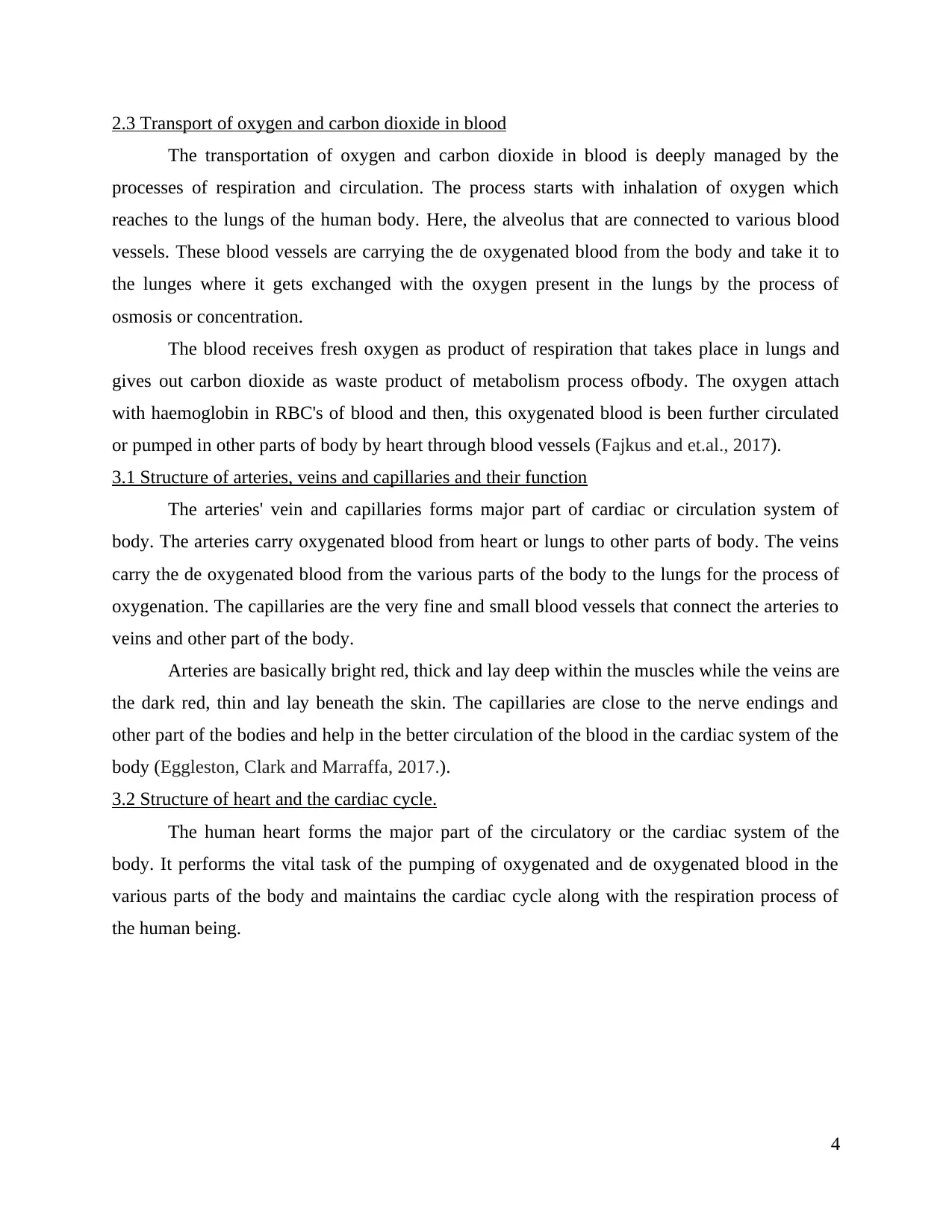
2.3 Transport of oxygen and carbon dioxide in blood
The transportation of oxygen and carbon dioxide in blood is deeply managed by the
processes of respiration and circulation. The process starts with inhalation of oxygen which
reaches to the lungs of the human body. Here, the alveolus that are connected to various blood
vessels. These blood vessels are carrying the de oxygenated blood from the body and take it to
the lunges where it gets exchanged with the oxygen present in the lungs by the process of
osmosis or concentration.
The blood receives fresh oxygen as product of respiration that takes place in lungs and
gives out carbon dioxide as waste product of metabolism process ofbody. The oxygen attach
with haemoglobin in RBC's of blood and then, this oxygenated blood is been further circulated
or pumped in other parts of body by heart through blood vessels (Fajkus and et.al., 2017).
3.1 Structure of arteries, veins and capillaries and their function
The arteries' vein and capillaries forms major part of cardiac or circulation system of
body. The arteries carry oxygenated blood from heart or lungs to other parts of body. The veins
carry the de oxygenated blood from the various parts of the body to the lungs for the process of
oxygenation. The capillaries are the very fine and small blood vessels that connect the arteries to
veins and other part of the body.
Arteries are basically bright red, thick and lay deep within the muscles while the veins are
the dark red, thin and lay beneath the skin. The capillaries are close to the nerve endings and
other part of the bodies and help in the better circulation of the blood in the cardiac system of the
body (Eggleston, Clark and Marraffa, 2017.).
3.2 Structure of heart and the cardiac cycle.
The human heart forms the major part of the circulatory or the cardiac system of the
body. It performs the vital task of the pumping of oxygenated and de oxygenated blood in the
various parts of the body and maintains the cardiac cycle along with the respiration process of
the human being.
4
The transportation of oxygen and carbon dioxide in blood is deeply managed by the
processes of respiration and circulation. The process starts with inhalation of oxygen which
reaches to the lungs of the human body. Here, the alveolus that are connected to various blood
vessels. These blood vessels are carrying the de oxygenated blood from the body and take it to
the lunges where it gets exchanged with the oxygen present in the lungs by the process of
osmosis or concentration.
The blood receives fresh oxygen as product of respiration that takes place in lungs and
gives out carbon dioxide as waste product of metabolism process ofbody. The oxygen attach
with haemoglobin in RBC's of blood and then, this oxygenated blood is been further circulated
or pumped in other parts of body by heart through blood vessels (Fajkus and et.al., 2017).
3.1 Structure of arteries, veins and capillaries and their function
The arteries' vein and capillaries forms major part of cardiac or circulation system of
body. The arteries carry oxygenated blood from heart or lungs to other parts of body. The veins
carry the de oxygenated blood from the various parts of the body to the lungs for the process of
oxygenation. The capillaries are the very fine and small blood vessels that connect the arteries to
veins and other part of the body.
Arteries are basically bright red, thick and lay deep within the muscles while the veins are
the dark red, thin and lay beneath the skin. The capillaries are close to the nerve endings and
other part of the bodies and help in the better circulation of the blood in the cardiac system of the
body (Eggleston, Clark and Marraffa, 2017.).
3.2 Structure of heart and the cardiac cycle.
The human heart forms the major part of the circulatory or the cardiac system of the
body. It performs the vital task of the pumping of oxygenated and de oxygenated blood in the
various parts of the body and maintains the cardiac cycle along with the respiration process of
the human being.
4
Paraphrase This Document
Need a fresh take? Get an instant paraphrase of this document with our AI Paraphraser
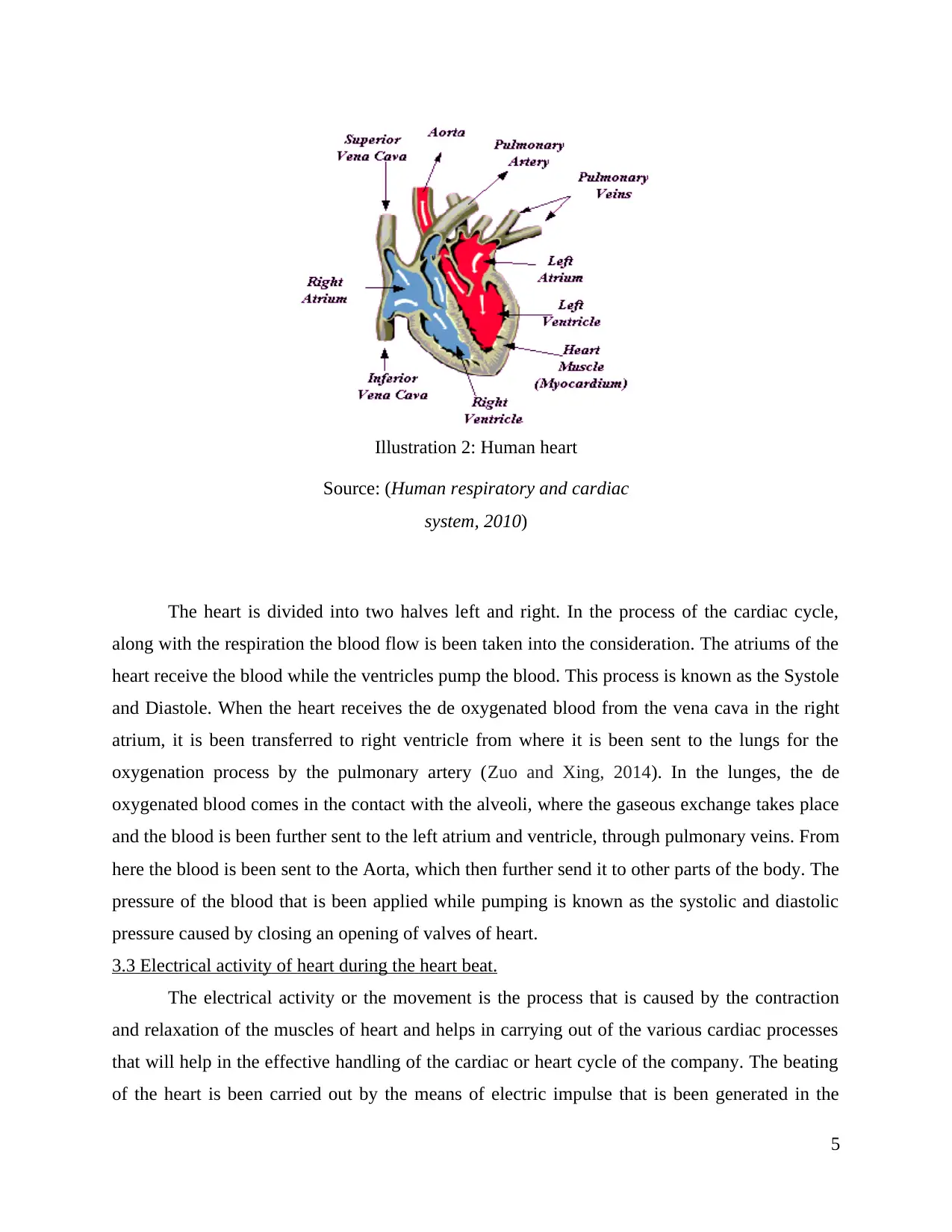
The heart is divided into two halves left and right. In the process of the cardiac cycle,
along with the respiration the blood flow is been taken into the consideration. The atriums of the
heart receive the blood while the ventricles pump the blood. This process is known as the Systole
and Diastole. When the heart receives the de oxygenated blood from the vena cava in the right
atrium, it is been transferred to right ventricle from where it is been sent to the lungs for the
oxygenation process by the pulmonary artery (Zuo and Xing, 2014). In the lunges, the de
oxygenated blood comes in the contact with the alveoli, where the gaseous exchange takes place
and the blood is been further sent to the left atrium and ventricle, through pulmonary veins. From
here the blood is been sent to the Aorta, which then further send it to other parts of the body. The
pressure of the blood that is been applied while pumping is known as the systolic and diastolic
pressure caused by closing an opening of valves of heart.
3.3 Electrical activity of heart during the heart beat.
The electrical activity or the movement is the process that is caused by the contraction
and relaxation of the muscles of heart and helps in carrying out of the various cardiac processes
that will help in the effective handling of the cardiac or heart cycle of the company. The beating
of the heart is been carried out by the means of electric impulse that is been generated in the
5
Illustration 2: Human heart
Source: (Human respiratory and cardiac
system, 2010)
along with the respiration the blood flow is been taken into the consideration. The atriums of the
heart receive the blood while the ventricles pump the blood. This process is known as the Systole
and Diastole. When the heart receives the de oxygenated blood from the vena cava in the right
atrium, it is been transferred to right ventricle from where it is been sent to the lungs for the
oxygenation process by the pulmonary artery (Zuo and Xing, 2014). In the lunges, the de
oxygenated blood comes in the contact with the alveoli, where the gaseous exchange takes place
and the blood is been further sent to the left atrium and ventricle, through pulmonary veins. From
here the blood is been sent to the Aorta, which then further send it to other parts of the body. The
pressure of the blood that is been applied while pumping is known as the systolic and diastolic
pressure caused by closing an opening of valves of heart.
3.3 Electrical activity of heart during the heart beat.
The electrical activity or the movement is the process that is caused by the contraction
and relaxation of the muscles of heart and helps in carrying out of the various cardiac processes
that will help in the effective handling of the cardiac or heart cycle of the company. The beating
of the heart is been carried out by the means of electric impulse that is been generated in the
5
Illustration 2: Human heart
Source: (Human respiratory and cardiac
system, 2010)
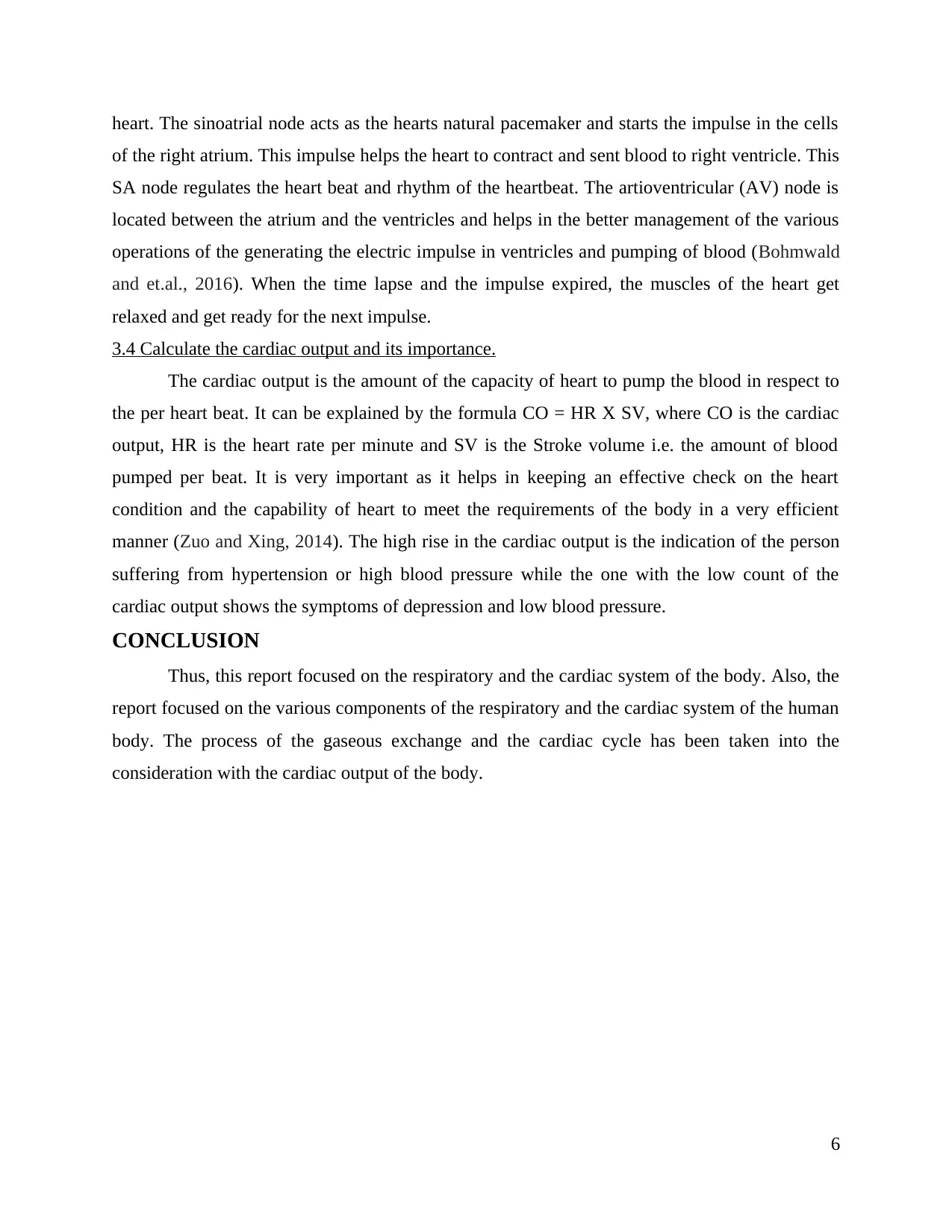
heart. The sinoatrial node acts as the hearts natural pacemaker and starts the impulse in the cells
of the right atrium. This impulse helps the heart to contract and sent blood to right ventricle. This
SA node regulates the heart beat and rhythm of the heartbeat. The artioventricular (AV) node is
located between the atrium and the ventricles and helps in the better management of the various
operations of the generating the electric impulse in ventricles and pumping of blood (Bohmwald
and et.al., 2016). When the time lapse and the impulse expired, the muscles of the heart get
relaxed and get ready for the next impulse.
3.4 Calculate the cardiac output and its importance.
The cardiac output is the amount of the capacity of heart to pump the blood in respect to
the per heart beat. It can be explained by the formula CO = HR X SV, where CO is the cardiac
output, HR is the heart rate per minute and SV is the Stroke volume i.e. the amount of blood
pumped per beat. It is very important as it helps in keeping an effective check on the heart
condition and the capability of heart to meet the requirements of the body in a very efficient
manner (Zuo and Xing, 2014). The high rise in the cardiac output is the indication of the person
suffering from hypertension or high blood pressure while the one with the low count of the
cardiac output shows the symptoms of depression and low blood pressure.
CONCLUSION
Thus, this report focused on the respiratory and the cardiac system of the body. Also, the
report focused on the various components of the respiratory and the cardiac system of the human
body. The process of the gaseous exchange and the cardiac cycle has been taken into the
consideration with the cardiac output of the body.
6
of the right atrium. This impulse helps the heart to contract and sent blood to right ventricle. This
SA node regulates the heart beat and rhythm of the heartbeat. The artioventricular (AV) node is
located between the atrium and the ventricles and helps in the better management of the various
operations of the generating the electric impulse in ventricles and pumping of blood (Bohmwald
and et.al., 2016). When the time lapse and the impulse expired, the muscles of the heart get
relaxed and get ready for the next impulse.
3.4 Calculate the cardiac output and its importance.
The cardiac output is the amount of the capacity of heart to pump the blood in respect to
the per heart beat. It can be explained by the formula CO = HR X SV, where CO is the cardiac
output, HR is the heart rate per minute and SV is the Stroke volume i.e. the amount of blood
pumped per beat. It is very important as it helps in keeping an effective check on the heart
condition and the capability of heart to meet the requirements of the body in a very efficient
manner (Zuo and Xing, 2014). The high rise in the cardiac output is the indication of the person
suffering from hypertension or high blood pressure while the one with the low count of the
cardiac output shows the symptoms of depression and low blood pressure.
CONCLUSION
Thus, this report focused on the respiratory and the cardiac system of the body. Also, the
report focused on the various components of the respiratory and the cardiac system of the human
body. The process of the gaseous exchange and the cardiac cycle has been taken into the
consideration with the cardiac output of the body.
6
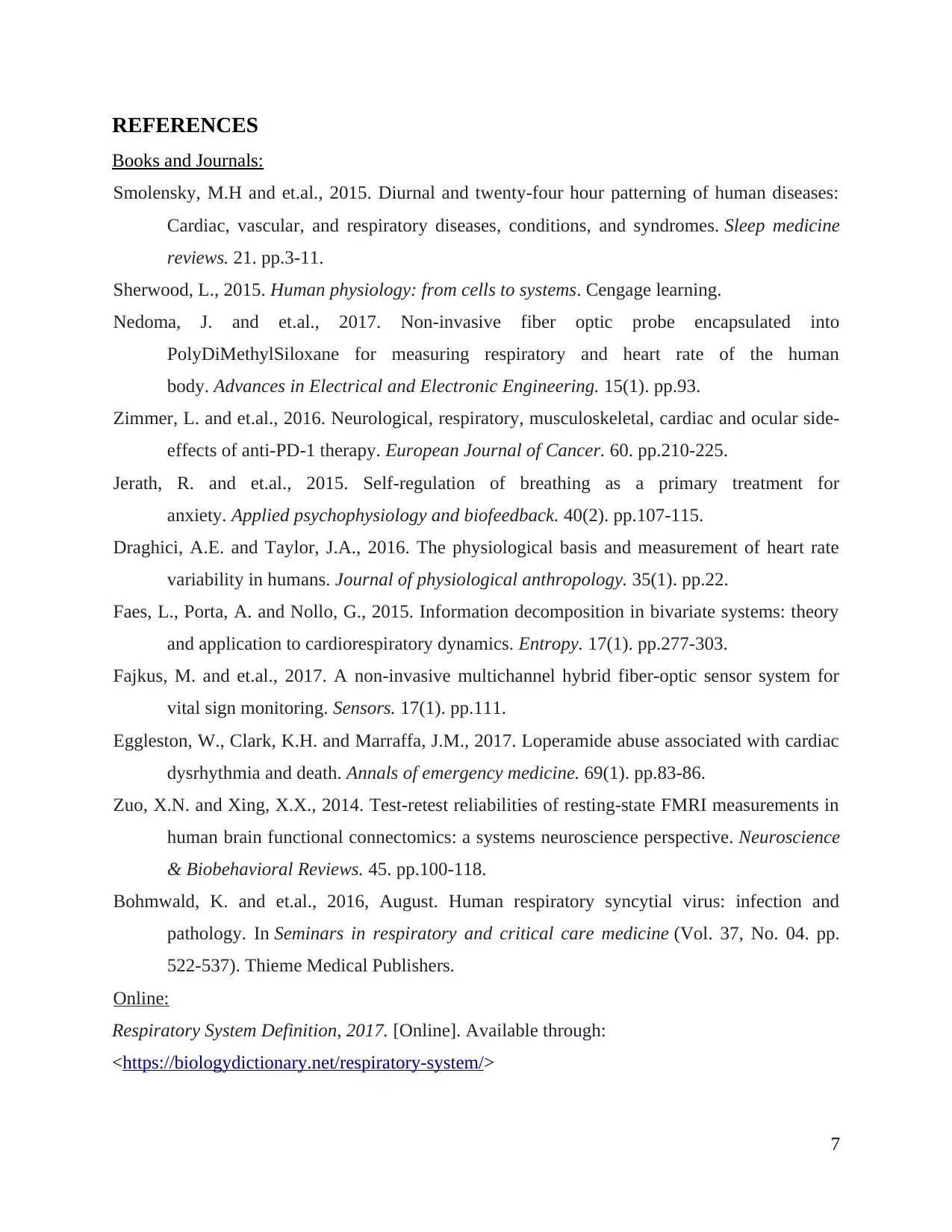
REFERENCES
Books and Journals:
Smolensky, M.H and et.al., 2015. Diurnal and twenty-four hour patterning of human diseases:
Cardiac, vascular, and respiratory diseases, conditions, and syndromes. Sleep medicine
reviews. 21. pp.3-11.
Sherwood, L., 2015. Human physiology: from cells to systems. Cengage learning.
Nedoma, J. and et.al., 2017. Non-invasive fiber optic probe encapsulated into
PolyDiMethylSiloxane for measuring respiratory and heart rate of the human
body. Advances in Electrical and Electronic Engineering. 15(1). pp.93.
Zimmer, L. and et.al., 2016. Neurological, respiratory, musculoskeletal, cardiac and ocular side-
effects of anti-PD-1 therapy. European Journal of Cancer. 60. pp.210-225.
Jerath, R. and et.al., 2015. Self-regulation of breathing as a primary treatment for
anxiety. Applied psychophysiology and biofeedback. 40(2). pp.107-115.
Draghici, A.E. and Taylor, J.A., 2016. The physiological basis and measurement of heart rate
variability in humans. Journal of physiological anthropology. 35(1). pp.22.
Faes, L., Porta, A. and Nollo, G., 2015. Information decomposition in bivariate systems: theory
and application to cardiorespiratory dynamics. Entropy. 17(1). pp.277-303.
Fajkus, M. and et.al., 2017. A non-invasive multichannel hybrid fiber-optic sensor system for
vital sign monitoring. Sensors. 17(1). pp.111.
Eggleston, W., Clark, K.H. and Marraffa, J.M., 2017. Loperamide abuse associated with cardiac
dysrhythmia and death. Annals of emergency medicine. 69(1). pp.83-86.
Zuo, X.N. and Xing, X.X., 2014. Test-retest reliabilities of resting-state FMRI measurements in
human brain functional connectomics: a systems neuroscience perspective. Neuroscience
& Biobehavioral Reviews. 45. pp.100-118.
Bohmwald, K. and et.al., 2016, August. Human respiratory syncytial virus: infection and
pathology. In Seminars in respiratory and critical care medicine (Vol. 37, No. 04. pp.
522-537). Thieme Medical Publishers.
Online:
Respiratory System Definition, 2017. [Online]. Available through:
<https://biologydictionary.net/respiratory-system/>
7
Books and Journals:
Smolensky, M.H and et.al., 2015. Diurnal and twenty-four hour patterning of human diseases:
Cardiac, vascular, and respiratory diseases, conditions, and syndromes. Sleep medicine
reviews. 21. pp.3-11.
Sherwood, L., 2015. Human physiology: from cells to systems. Cengage learning.
Nedoma, J. and et.al., 2017. Non-invasive fiber optic probe encapsulated into
PolyDiMethylSiloxane for measuring respiratory and heart rate of the human
body. Advances in Electrical and Electronic Engineering. 15(1). pp.93.
Zimmer, L. and et.al., 2016. Neurological, respiratory, musculoskeletal, cardiac and ocular side-
effects of anti-PD-1 therapy. European Journal of Cancer. 60. pp.210-225.
Jerath, R. and et.al., 2015. Self-regulation of breathing as a primary treatment for
anxiety. Applied psychophysiology and biofeedback. 40(2). pp.107-115.
Draghici, A.E. and Taylor, J.A., 2016. The physiological basis and measurement of heart rate
variability in humans. Journal of physiological anthropology. 35(1). pp.22.
Faes, L., Porta, A. and Nollo, G., 2015. Information decomposition in bivariate systems: theory
and application to cardiorespiratory dynamics. Entropy. 17(1). pp.277-303.
Fajkus, M. and et.al., 2017. A non-invasive multichannel hybrid fiber-optic sensor system for
vital sign monitoring. Sensors. 17(1). pp.111.
Eggleston, W., Clark, K.H. and Marraffa, J.M., 2017. Loperamide abuse associated with cardiac
dysrhythmia and death. Annals of emergency medicine. 69(1). pp.83-86.
Zuo, X.N. and Xing, X.X., 2014. Test-retest reliabilities of resting-state FMRI measurements in
human brain functional connectomics: a systems neuroscience perspective. Neuroscience
& Biobehavioral Reviews. 45. pp.100-118.
Bohmwald, K. and et.al., 2016, August. Human respiratory syncytial virus: infection and
pathology. In Seminars in respiratory and critical care medicine (Vol. 37, No. 04. pp.
522-537). Thieme Medical Publishers.
Online:
Respiratory System Definition, 2017. [Online]. Available through:
<https://biologydictionary.net/respiratory-system/>
7
Secure Best Marks with AI Grader
Need help grading? Try our AI Grader for instant feedback on your assignments.
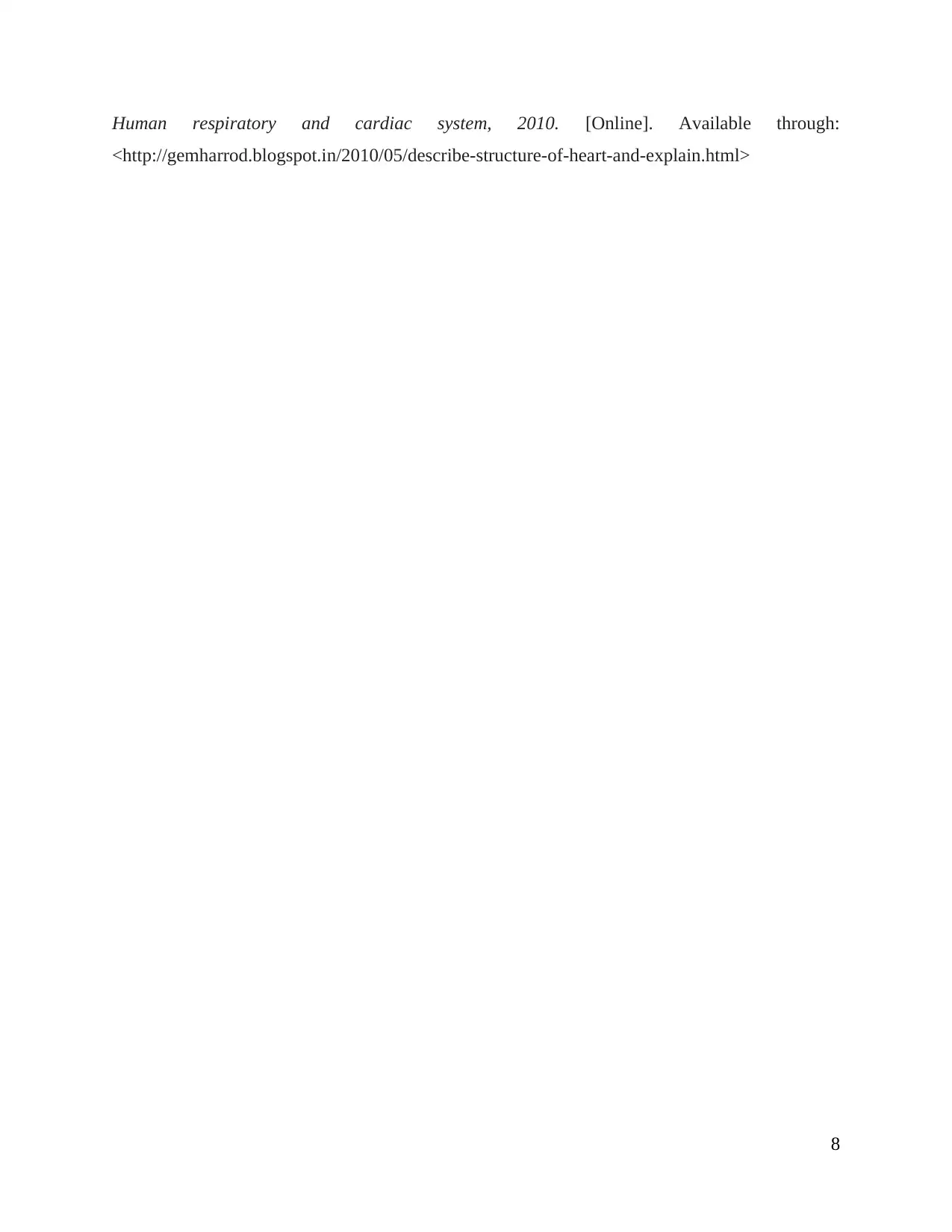
Human respiratory and cardiac system, 2010. [Online]. Available through:
<http://gemharrod.blogspot.in/2010/05/describe-structure-of-heart-and-explain.html>
8
<http://gemharrod.blogspot.in/2010/05/describe-structure-of-heart-and-explain.html>
8
1 out of 11
Related Documents
Your All-in-One AI-Powered Toolkit for Academic Success.
+13062052269
info@desklib.com
Available 24*7 on WhatsApp / Email
![[object Object]](/_next/static/media/star-bottom.7253800d.svg)
Unlock your academic potential
© 2024 | Zucol Services PVT LTD | All rights reserved.




